Performance Reward Management: An In-Depth Analysis and Evaluation
VerifiedAdded on 2022/08/23
|29
|7592
|21
Report
AI Summary
This report delves into the multifaceted realm of performance reward management, commencing with an exploration of its core purposes and its vital relationship to overarching business objectives. It dissects the fundamental components that constitute effective performance management systems, providing a comprehensive understanding of their structure and functionality. The report further investigates the crucial link between motivation and performance management, drawing upon established motivational theories to illuminate the underlying dynamics. It proceeds to examine the strategic role of rewards within performance management systems, delineating the diverse components of a total reward system, including both financial and non-financial incentives. The report also addresses the critical aspects of managing both exemplary and deficient performance, providing practical insights and recommendations. Furthermore, it outlines the data sources essential for informed decision-making and the processes involved in conducting thorough performance reviews. The report culminates with a reflective analysis of the outcomes of a performance review, offering insights into effectiveness and areas for future improvement. This report offers a valuable resource for students seeking to understand and implement effective performance reward management strategies.
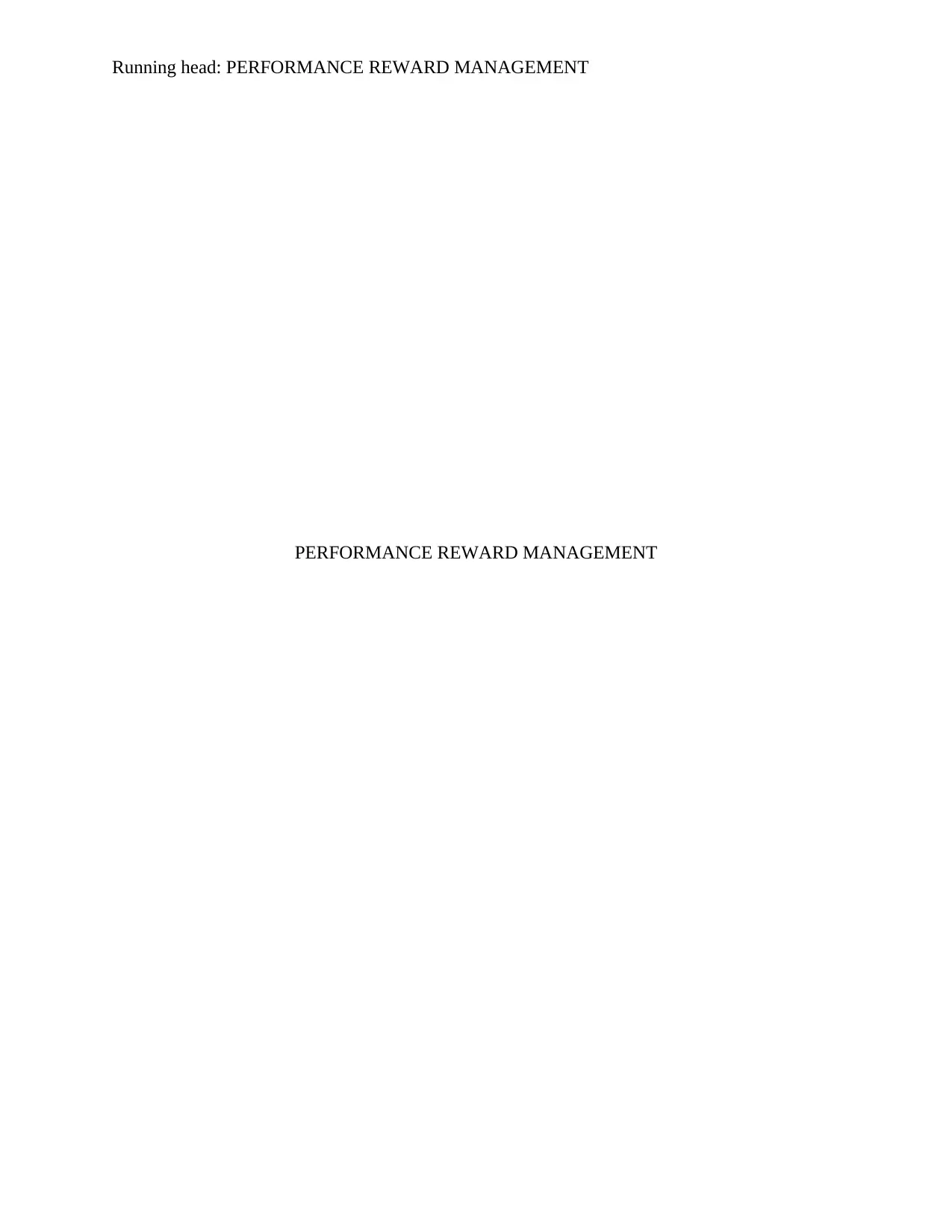
Running head: PERFORMANCE REWARD MANAGEMENT
PERFORMANCE REWARD MANAGEMENT
PERFORMANCE REWARD MANAGEMENT
Paraphrase This Document
Need a fresh take? Get an instant paraphrase of this document with our AI Paraphraser
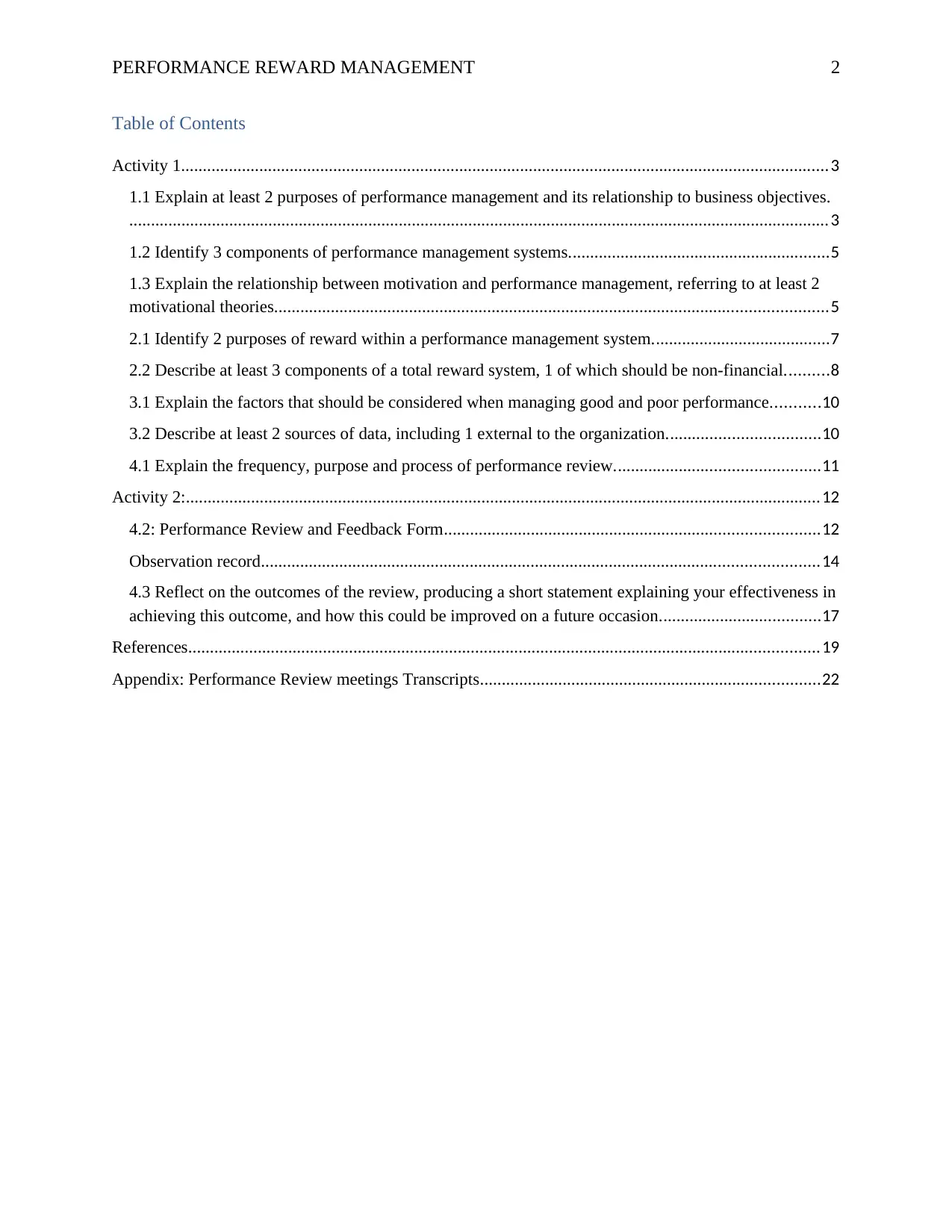
PERFORMANCE REWARD MANAGEMENT 2
Table of Contents
Activity 1.....................................................................................................................................................3
1.1 Explain at least 2 purposes of performance management and its relationship to business objectives.
.................................................................................................................................................................3
1.2 Identify 3 components of performance management systems............................................................5
1.3 Explain the relationship between motivation and performance management, referring to at least 2
motivational theories...............................................................................................................................5
2.1 Identify 2 purposes of reward within a performance management system.........................................7
2.2 Describe at least 3 components of a total reward system, 1 of which should be non-financial..........8
3.1 Explain the factors that should be considered when managing good and poor performance...........10
3.2 Describe at least 2 sources of data, including 1 external to the organization...................................10
4.1 Explain the frequency, purpose and process of performance review...............................................11
Activity 2:..................................................................................................................................................12
4.2: Performance Review and Feedback Form......................................................................................12
Observation record................................................................................................................................14
4.3 Reflect on the outcomes of the review, producing a short statement explaining your effectiveness in
achieving this outcome, and how this could be improved on a future occasion.....................................17
References.................................................................................................................................................19
Appendix: Performance Review meetings Transcripts..............................................................................22
Table of Contents
Activity 1.....................................................................................................................................................3
1.1 Explain at least 2 purposes of performance management and its relationship to business objectives.
.................................................................................................................................................................3
1.2 Identify 3 components of performance management systems............................................................5
1.3 Explain the relationship between motivation and performance management, referring to at least 2
motivational theories...............................................................................................................................5
2.1 Identify 2 purposes of reward within a performance management system.........................................7
2.2 Describe at least 3 components of a total reward system, 1 of which should be non-financial..........8
3.1 Explain the factors that should be considered when managing good and poor performance...........10
3.2 Describe at least 2 sources of data, including 1 external to the organization...................................10
4.1 Explain the frequency, purpose and process of performance review...............................................11
Activity 2:..................................................................................................................................................12
4.2: Performance Review and Feedback Form......................................................................................12
Observation record................................................................................................................................14
4.3 Reflect on the outcomes of the review, producing a short statement explaining your effectiveness in
achieving this outcome, and how this could be improved on a future occasion.....................................17
References.................................................................................................................................................19
Appendix: Performance Review meetings Transcripts..............................................................................22
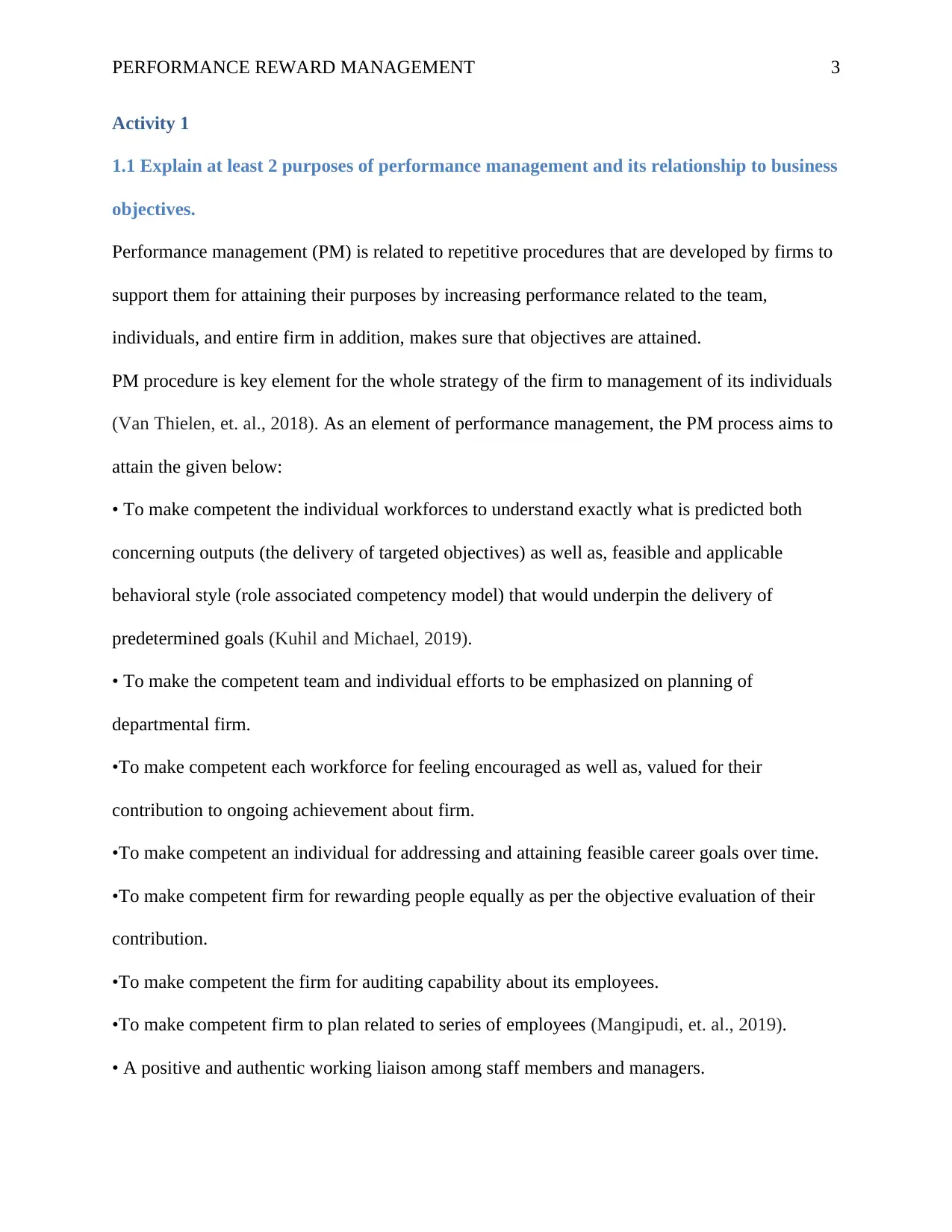
PERFORMANCE REWARD MANAGEMENT 3
Activity 1
1.1 Explain at least 2 purposes of performance management and its relationship to business
objectives.
Performance management (PM) is related to repetitive procedures that are developed by firms to
support them for attaining their purposes by increasing performance related to the team,
individuals, and entire firm in addition, makes sure that objectives are attained.
PM procedure is key element for the whole strategy of the firm to management of its individuals
(Van Thielen, et. al., 2018). As an element of performance management, the PM process aims to
attain the given below:
• To make competent the individual workforces to understand exactly what is predicted both
concerning outputs (the delivery of targeted objectives) as well as, feasible and applicable
behavioral style (role associated competency model) that would underpin the delivery of
predetermined goals (Kuhil and Michael, 2019).
• To make the competent team and individual efforts to be emphasized on planning of
departmental firm.
•To make competent each workforce for feeling encouraged as well as, valued for their
contribution to ongoing achievement about firm.
•To make competent an individual for addressing and attaining feasible career goals over time.
•To make competent firm for rewarding people equally as per the objective evaluation of their
contribution.
•To make competent the firm for auditing capability about its employees.
•To make competent firm to plan related to series of employees (Mangipudi, et. al., 2019).
• A positive and authentic working liaison among staff members and managers.
Activity 1
1.1 Explain at least 2 purposes of performance management and its relationship to business
objectives.
Performance management (PM) is related to repetitive procedures that are developed by firms to
support them for attaining their purposes by increasing performance related to the team,
individuals, and entire firm in addition, makes sure that objectives are attained.
PM procedure is key element for the whole strategy of the firm to management of its individuals
(Van Thielen, et. al., 2018). As an element of performance management, the PM process aims to
attain the given below:
• To make competent the individual workforces to understand exactly what is predicted both
concerning outputs (the delivery of targeted objectives) as well as, feasible and applicable
behavioral style (role associated competency model) that would underpin the delivery of
predetermined goals (Kuhil and Michael, 2019).
• To make the competent team and individual efforts to be emphasized on planning of
departmental firm.
•To make competent each workforce for feeling encouraged as well as, valued for their
contribution to ongoing achievement about firm.
•To make competent an individual for addressing and attaining feasible career goals over time.
•To make competent firm for rewarding people equally as per the objective evaluation of their
contribution.
•To make competent the firm for auditing capability about its employees.
•To make competent firm to plan related to series of employees (Mangipudi, et. al., 2019).
• A positive and authentic working liaison among staff members and managers.
⊘ This is a preview!⊘
Do you want full access?
Subscribe today to unlock all pages.

Trusted by 1+ million students worldwide
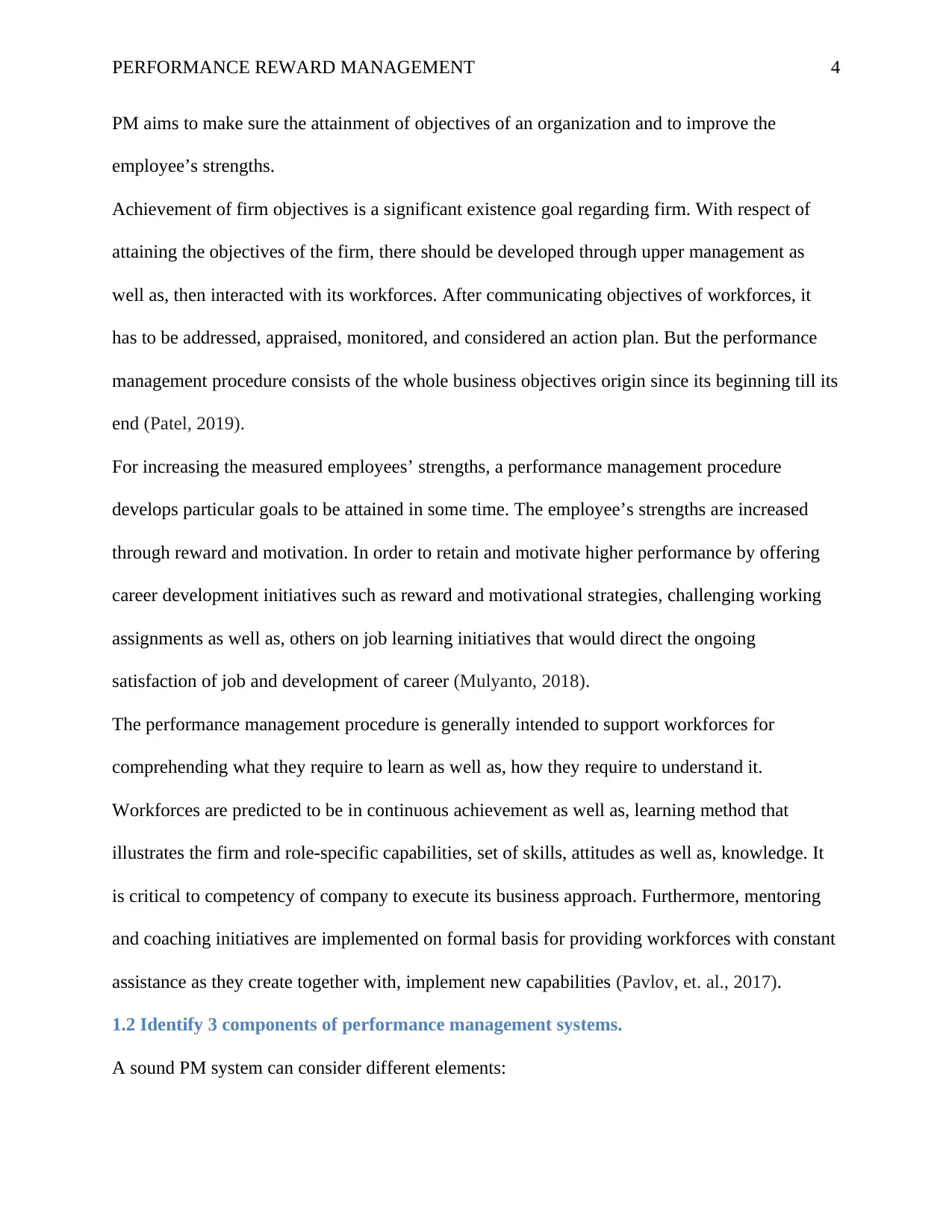
PERFORMANCE REWARD MANAGEMENT 4
PM aims to make sure the attainment of objectives of an organization and to improve the
employee’s strengths.
Achievement of firm objectives is a significant existence goal regarding firm. With respect of
attaining the objectives of the firm, there should be developed through upper management as
well as, then interacted with its workforces. After communicating objectives of workforces, it
has to be addressed, appraised, monitored, and considered an action plan. But the performance
management procedure consists of the whole business objectives origin since its beginning till its
end (Patel, 2019).
For increasing the measured employees’ strengths, a performance management procedure
develops particular goals to be attained in some time. The employee’s strengths are increased
through reward and motivation. In order to retain and motivate higher performance by offering
career development initiatives such as reward and motivational strategies, challenging working
assignments as well as, others on job learning initiatives that would direct the ongoing
satisfaction of job and development of career (Mulyanto, 2018).
The performance management procedure is generally intended to support workforces for
comprehending what they require to learn as well as, how they require to understand it.
Workforces are predicted to be in continuous achievement as well as, learning method that
illustrates the firm and role-specific capabilities, set of skills, attitudes as well as, knowledge. It
is critical to competency of company to execute its business approach. Furthermore, mentoring
and coaching initiatives are implemented on formal basis for providing workforces with constant
assistance as they create together with, implement new capabilities (Pavlov, et. al., 2017).
1.2 Identify 3 components of performance management systems.
A sound PM system can consider different elements:
PM aims to make sure the attainment of objectives of an organization and to improve the
employee’s strengths.
Achievement of firm objectives is a significant existence goal regarding firm. With respect of
attaining the objectives of the firm, there should be developed through upper management as
well as, then interacted with its workforces. After communicating objectives of workforces, it
has to be addressed, appraised, monitored, and considered an action plan. But the performance
management procedure consists of the whole business objectives origin since its beginning till its
end (Patel, 2019).
For increasing the measured employees’ strengths, a performance management procedure
develops particular goals to be attained in some time. The employee’s strengths are increased
through reward and motivation. In order to retain and motivate higher performance by offering
career development initiatives such as reward and motivational strategies, challenging working
assignments as well as, others on job learning initiatives that would direct the ongoing
satisfaction of job and development of career (Mulyanto, 2018).
The performance management procedure is generally intended to support workforces for
comprehending what they require to learn as well as, how they require to understand it.
Workforces are predicted to be in continuous achievement as well as, learning method that
illustrates the firm and role-specific capabilities, set of skills, attitudes as well as, knowledge. It
is critical to competency of company to execute its business approach. Furthermore, mentoring
and coaching initiatives are implemented on formal basis for providing workforces with constant
assistance as they create together with, implement new capabilities (Pavlov, et. al., 2017).
1.2 Identify 3 components of performance management systems.
A sound PM system can consider different elements:
Paraphrase This Document
Need a fresh take? Get an instant paraphrase of this document with our AI Paraphraser
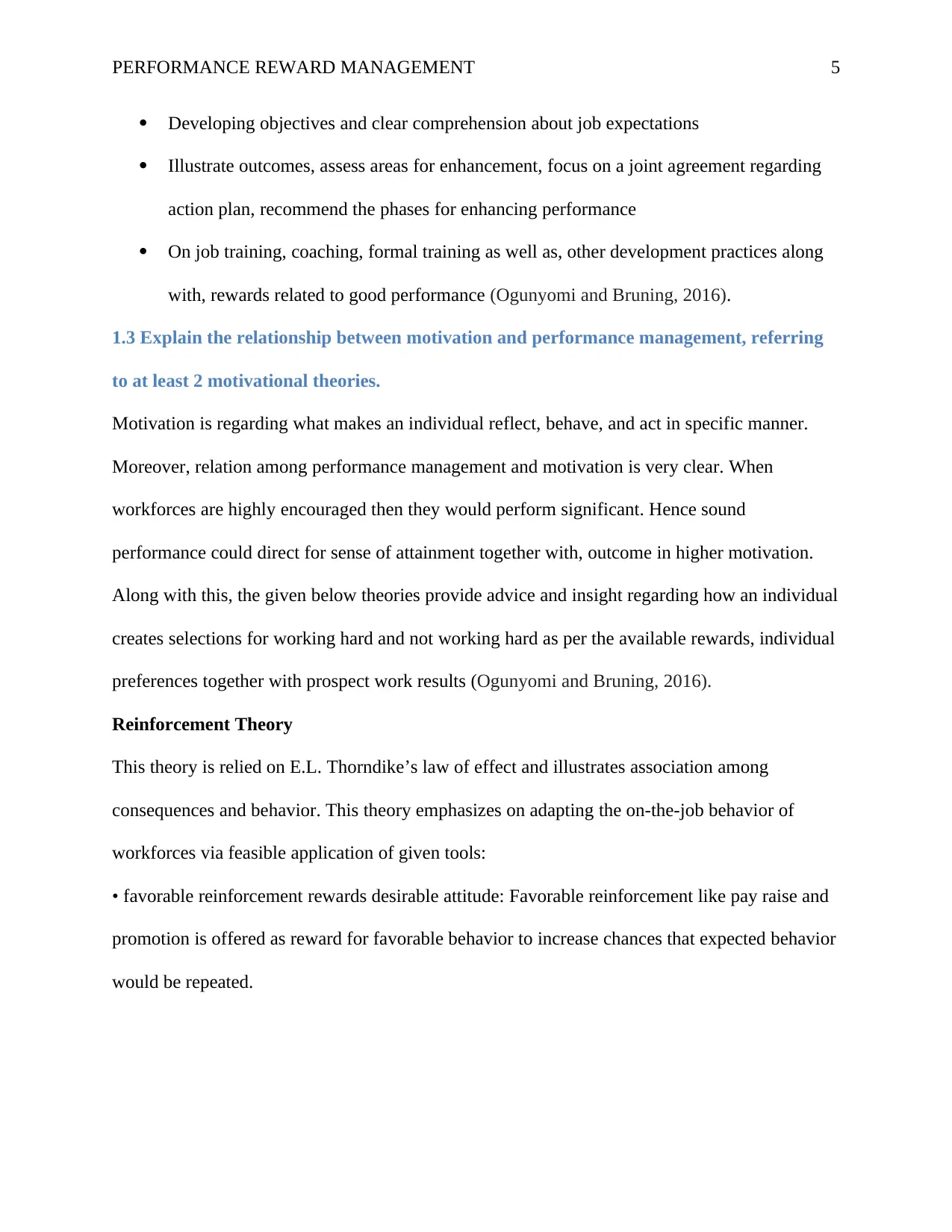
PERFORMANCE REWARD MANAGEMENT 5
Developing objectives and clear comprehension about job expectations
Illustrate outcomes, assess areas for enhancement, focus on a joint agreement regarding
action plan, recommend the phases for enhancing performance
On job training, coaching, formal training as well as, other development practices along
with, rewards related to good performance (Ogunyomi and Bruning, 2016).
1.3 Explain the relationship between motivation and performance management, referring
to at least 2 motivational theories.
Motivation is regarding what makes an individual reflect, behave, and act in specific manner.
Moreover, relation among performance management and motivation is very clear. When
workforces are highly encouraged then they would perform significant. Hence sound
performance could direct for sense of attainment together with, outcome in higher motivation.
Along with this, the given below theories provide advice and insight regarding how an individual
creates selections for working hard and not working hard as per the available rewards, individual
preferences together with prospect work results (Ogunyomi and Bruning, 2016).
Reinforcement Theory
This theory is relied on E.L. Thorndike’s law of effect and illustrates association among
consequences and behavior. This theory emphasizes on adapting the on-the-job behavior of
workforces via feasible application of given tools:
• favorable reinforcement rewards desirable attitude: Favorable reinforcement like pay raise and
promotion is offered as reward for favorable behavior to increase chances that expected behavior
would be repeated.
Developing objectives and clear comprehension about job expectations
Illustrate outcomes, assess areas for enhancement, focus on a joint agreement regarding
action plan, recommend the phases for enhancing performance
On job training, coaching, formal training as well as, other development practices along
with, rewards related to good performance (Ogunyomi and Bruning, 2016).
1.3 Explain the relationship between motivation and performance management, referring
to at least 2 motivational theories.
Motivation is regarding what makes an individual reflect, behave, and act in specific manner.
Moreover, relation among performance management and motivation is very clear. When
workforces are highly encouraged then they would perform significant. Hence sound
performance could direct for sense of attainment together with, outcome in higher motivation.
Along with this, the given below theories provide advice and insight regarding how an individual
creates selections for working hard and not working hard as per the available rewards, individual
preferences together with prospect work results (Ogunyomi and Bruning, 2016).
Reinforcement Theory
This theory is relied on E.L. Thorndike’s law of effect and illustrates association among
consequences and behavior. This theory emphasizes on adapting the on-the-job behavior of
workforces via feasible application of given tools:
• favorable reinforcement rewards desirable attitude: Favorable reinforcement like pay raise and
promotion is offered as reward for favorable behavior to increase chances that expected behavior
would be repeated.
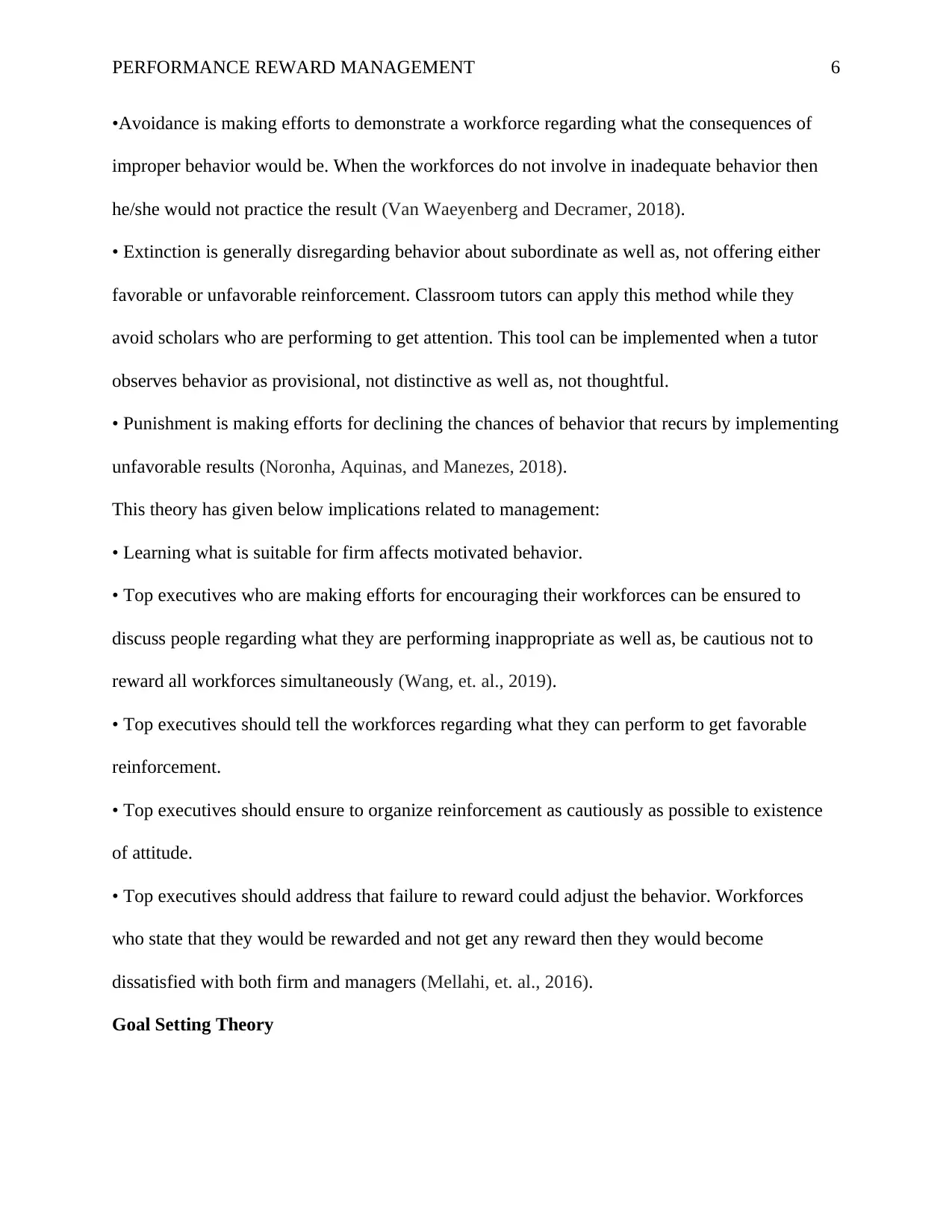
PERFORMANCE REWARD MANAGEMENT 6
•Avoidance is making efforts to demonstrate a workforce regarding what the consequences of
improper behavior would be. When the workforces do not involve in inadequate behavior then
he/she would not practice the result (Van Waeyenberg and Decramer, 2018).
• Extinction is generally disregarding behavior about subordinate as well as, not offering either
favorable or unfavorable reinforcement. Classroom tutors can apply this method while they
avoid scholars who are performing to get attention. This tool can be implemented when a tutor
observes behavior as provisional, not distinctive as well as, not thoughtful.
• Punishment is making efforts for declining the chances of behavior that recurs by implementing
unfavorable results (Noronha, Aquinas, and Manezes, 2018).
This theory has given below implications related to management:
• Learning what is suitable for firm affects motivated behavior.
• Top executives who are making efforts for encouraging their workforces can be ensured to
discuss people regarding what they are performing inappropriate as well as, be cautious not to
reward all workforces simultaneously (Wang, et. al., 2019).
• Top executives should tell the workforces regarding what they can perform to get favorable
reinforcement.
• Top executives should ensure to organize reinforcement as cautiously as possible to existence
of attitude.
• Top executives should address that failure to reward could adjust the behavior. Workforces
who state that they would be rewarded and not get any reward then they would become
dissatisfied with both firm and managers (Mellahi, et. al., 2016).
Goal Setting Theory
•Avoidance is making efforts to demonstrate a workforce regarding what the consequences of
improper behavior would be. When the workforces do not involve in inadequate behavior then
he/she would not practice the result (Van Waeyenberg and Decramer, 2018).
• Extinction is generally disregarding behavior about subordinate as well as, not offering either
favorable or unfavorable reinforcement. Classroom tutors can apply this method while they
avoid scholars who are performing to get attention. This tool can be implemented when a tutor
observes behavior as provisional, not distinctive as well as, not thoughtful.
• Punishment is making efforts for declining the chances of behavior that recurs by implementing
unfavorable results (Noronha, Aquinas, and Manezes, 2018).
This theory has given below implications related to management:
• Learning what is suitable for firm affects motivated behavior.
• Top executives who are making efforts for encouraging their workforces can be ensured to
discuss people regarding what they are performing inappropriate as well as, be cautious not to
reward all workforces simultaneously (Wang, et. al., 2019).
• Top executives should tell the workforces regarding what they can perform to get favorable
reinforcement.
• Top executives should ensure to organize reinforcement as cautiously as possible to existence
of attitude.
• Top executives should address that failure to reward could adjust the behavior. Workforces
who state that they would be rewarded and not get any reward then they would become
dissatisfied with both firm and managers (Mellahi, et. al., 2016).
Goal Setting Theory
⊘ This is a preview!⊘
Do you want full access?
Subscribe today to unlock all pages.

Trusted by 1+ million students worldwide
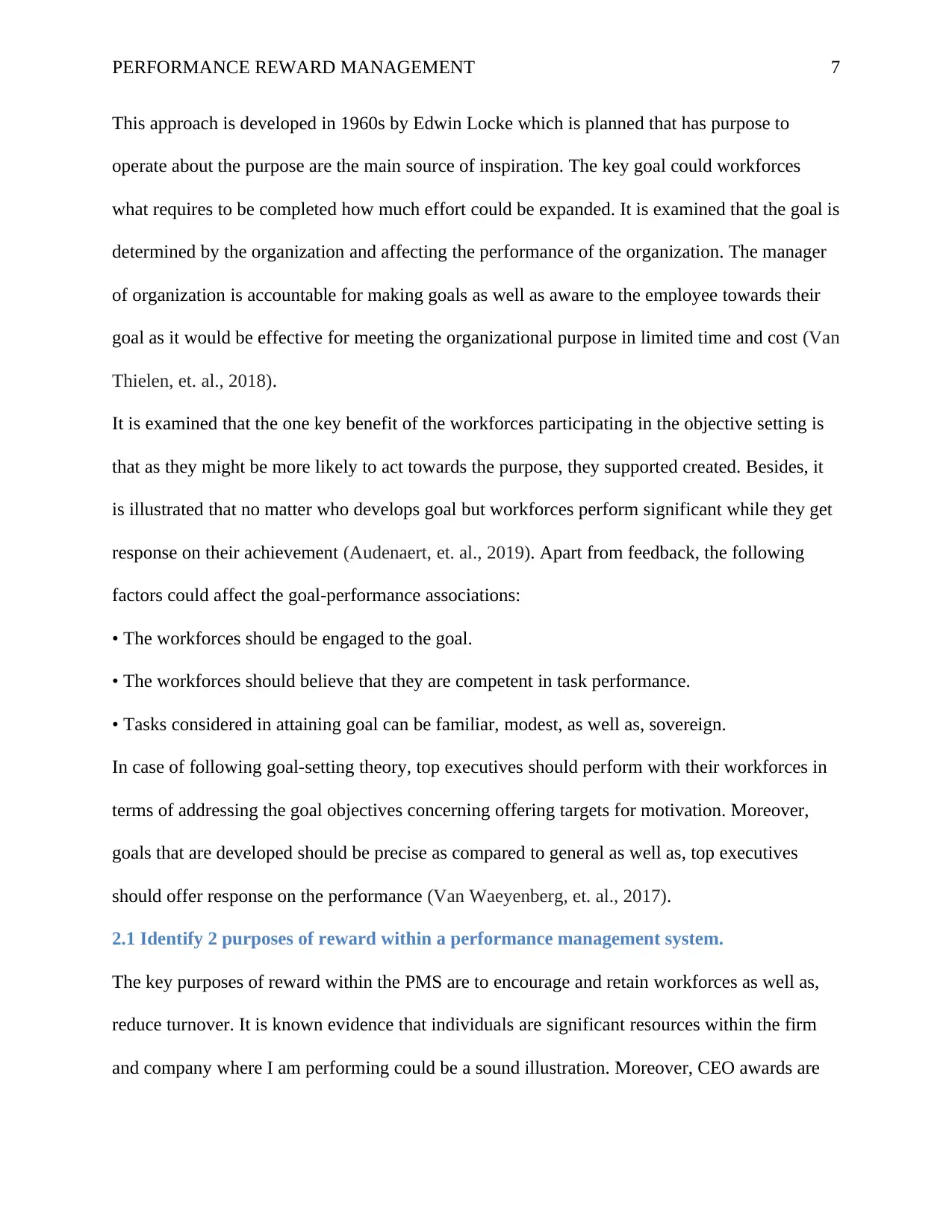
PERFORMANCE REWARD MANAGEMENT 7
This approach is developed in 1960s by Edwin Locke which is planned that has purpose to
operate about the purpose are the main source of inspiration. The key goal could workforces
what requires to be completed how much effort could be expanded. It is examined that the goal is
determined by the organization and affecting the performance of the organization. The manager
of organization is accountable for making goals as well as aware to the employee towards their
goal as it would be effective for meeting the organizational purpose in limited time and cost (Van
Thielen, et. al., 2018).
It is examined that the one key benefit of the workforces participating in the objective setting is
that as they might be more likely to act towards the purpose, they supported created. Besides, it
is illustrated that no matter who develops goal but workforces perform significant while they get
response on their achievement (Audenaert, et. al., 2019). Apart from feedback, the following
factors could affect the goal-performance associations:
• The workforces should be engaged to the goal.
• The workforces should believe that they are competent in task performance.
• Tasks considered in attaining goal can be familiar, modest, as well as, sovereign.
In case of following goal-setting theory, top executives should perform with their workforces in
terms of addressing the goal objectives concerning offering targets for motivation. Moreover,
goals that are developed should be precise as compared to general as well as, top executives
should offer response on the performance (Van Waeyenberg, et. al., 2017).
2.1 Identify 2 purposes of reward within a performance management system.
The key purposes of reward within the PMS are to encourage and retain workforces as well as,
reduce turnover. It is known evidence that individuals are significant resources within the firm
and company where I am performing could be a sound illustration. Moreover, CEO awards are
This approach is developed in 1960s by Edwin Locke which is planned that has purpose to
operate about the purpose are the main source of inspiration. The key goal could workforces
what requires to be completed how much effort could be expanded. It is examined that the goal is
determined by the organization and affecting the performance of the organization. The manager
of organization is accountable for making goals as well as aware to the employee towards their
goal as it would be effective for meeting the organizational purpose in limited time and cost (Van
Thielen, et. al., 2018).
It is examined that the one key benefit of the workforces participating in the objective setting is
that as they might be more likely to act towards the purpose, they supported created. Besides, it
is illustrated that no matter who develops goal but workforces perform significant while they get
response on their achievement (Audenaert, et. al., 2019). Apart from feedback, the following
factors could affect the goal-performance associations:
• The workforces should be engaged to the goal.
• The workforces should believe that they are competent in task performance.
• Tasks considered in attaining goal can be familiar, modest, as well as, sovereign.
In case of following goal-setting theory, top executives should perform with their workforces in
terms of addressing the goal objectives concerning offering targets for motivation. Moreover,
goals that are developed should be precise as compared to general as well as, top executives
should offer response on the performance (Van Waeyenberg, et. al., 2017).
2.1 Identify 2 purposes of reward within a performance management system.
The key purposes of reward within the PMS are to encourage and retain workforces as well as,
reduce turnover. It is known evidence that individuals are significant resources within the firm
and company where I am performing could be a sound illustration. Moreover, CEO awards are
Paraphrase This Document
Need a fresh take? Get an instant paraphrase of this document with our AI Paraphraser
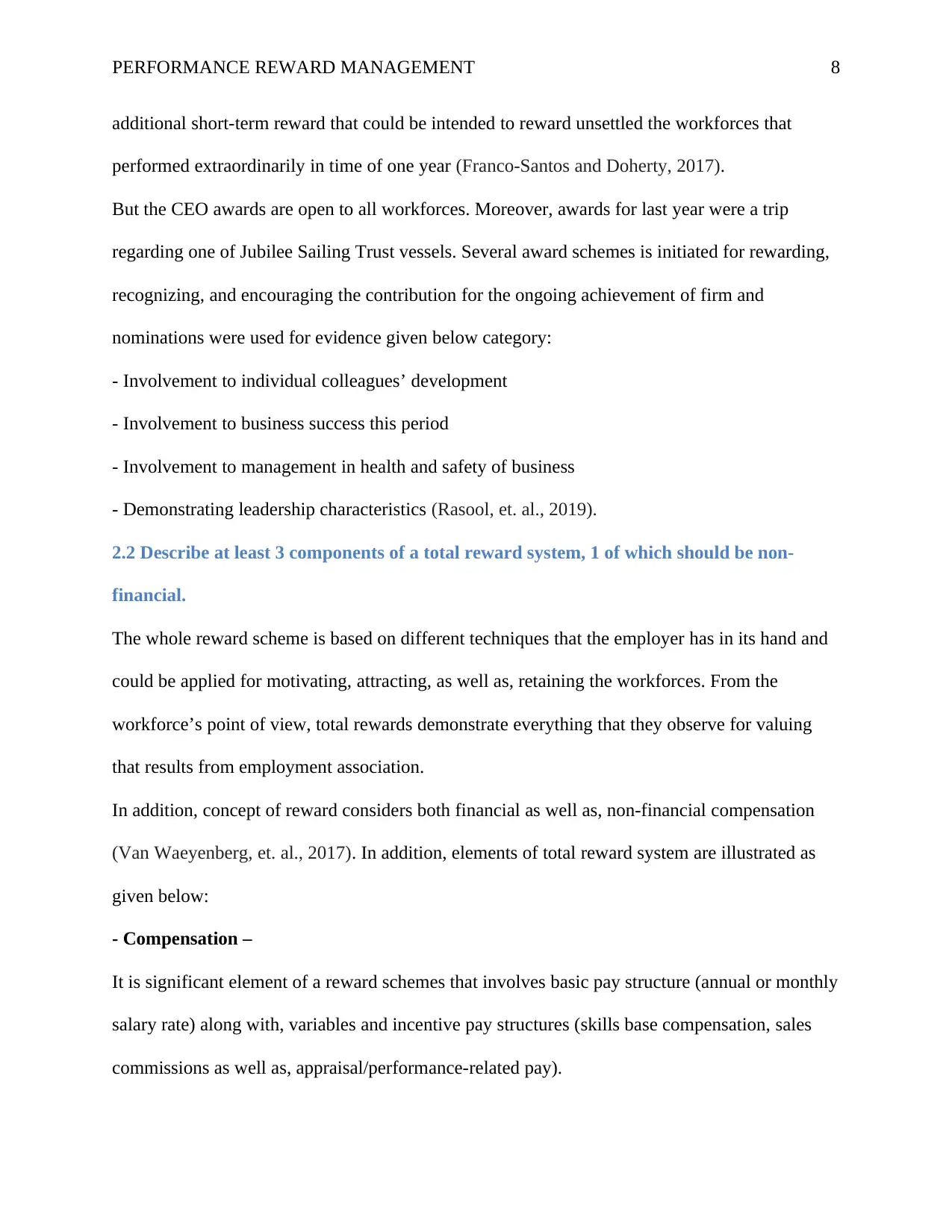
PERFORMANCE REWARD MANAGEMENT 8
additional short-term reward that could be intended to reward unsettled the workforces that
performed extraordinarily in time of one year (Franco-Santos and Doherty, 2017).
But the CEO awards are open to all workforces. Moreover, awards for last year were a trip
regarding one of Jubilee Sailing Trust vessels. Several award schemes is initiated for rewarding,
recognizing, and encouraging the contribution for the ongoing achievement of firm and
nominations were used for evidence given below category:
- Involvement to individual colleagues’ development
- Involvement to business success this period
- Involvement to management in health and safety of business
- Demonstrating leadership characteristics (Rasool, et. al., 2019).
2.2 Describe at least 3 components of a total reward system, 1 of which should be non-
financial.
The whole reward scheme is based on different techniques that the employer has in its hand and
could be applied for motivating, attracting, as well as, retaining the workforces. From the
workforce’s point of view, total rewards demonstrate everything that they observe for valuing
that results from employment association.
In addition, concept of reward considers both financial as well as, non-financial compensation
(Van Waeyenberg, et. al., 2017). In addition, elements of total reward system are illustrated as
given below:
- Compensation –
It is significant element of a reward schemes that involves basic pay structure (annual or monthly
salary rate) along with, variables and incentive pay structures (skills base compensation, sales
commissions as well as, appraisal/performance-related pay).
additional short-term reward that could be intended to reward unsettled the workforces that
performed extraordinarily in time of one year (Franco-Santos and Doherty, 2017).
But the CEO awards are open to all workforces. Moreover, awards for last year were a trip
regarding one of Jubilee Sailing Trust vessels. Several award schemes is initiated for rewarding,
recognizing, and encouraging the contribution for the ongoing achievement of firm and
nominations were used for evidence given below category:
- Involvement to individual colleagues’ development
- Involvement to business success this period
- Involvement to management in health and safety of business
- Demonstrating leadership characteristics (Rasool, et. al., 2019).
2.2 Describe at least 3 components of a total reward system, 1 of which should be non-
financial.
The whole reward scheme is based on different techniques that the employer has in its hand and
could be applied for motivating, attracting, as well as, retaining the workforces. From the
workforce’s point of view, total rewards demonstrate everything that they observe for valuing
that results from employment association.
In addition, concept of reward considers both financial as well as, non-financial compensation
(Van Waeyenberg, et. al., 2017). In addition, elements of total reward system are illustrated as
given below:
- Compensation –
It is significant element of a reward schemes that involves basic pay structure (annual or monthly
salary rate) along with, variables and incentive pay structures (skills base compensation, sales
commissions as well as, appraisal/performance-related pay).
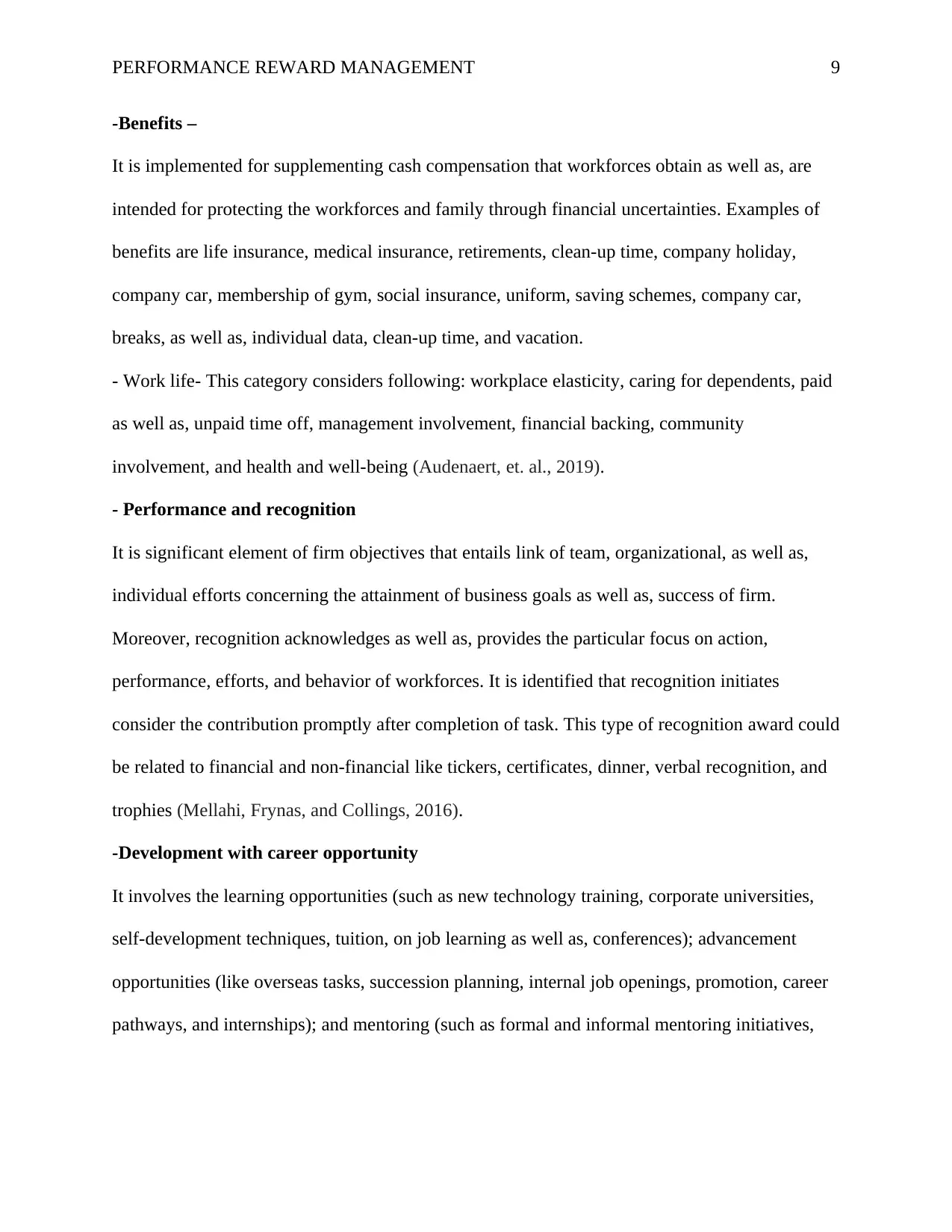
PERFORMANCE REWARD MANAGEMENT 9
-Benefits –
It is implemented for supplementing cash compensation that workforces obtain as well as, are
intended for protecting the workforces and family through financial uncertainties. Examples of
benefits are life insurance, medical insurance, retirements, clean-up time, company holiday,
company car, membership of gym, social insurance, uniform, saving schemes, company car,
breaks, as well as, individual data, clean-up time, and vacation.
- Work life- This category considers following: workplace elasticity, caring for dependents, paid
as well as, unpaid time off, management involvement, financial backing, community
involvement, and health and well-being (Audenaert, et. al., 2019).
- Performance and recognition
It is significant element of firm objectives that entails link of team, organizational, as well as,
individual efforts concerning the attainment of business goals as well as, success of firm.
Moreover, recognition acknowledges as well as, provides the particular focus on action,
performance, efforts, and behavior of workforces. It is identified that recognition initiates
consider the contribution promptly after completion of task. This type of recognition award could
be related to financial and non-financial like tickers, certificates, dinner, verbal recognition, and
trophies (Mellahi, Frynas, and Collings, 2016).
-Development with career opportunity
It involves the learning opportunities (such as new technology training, corporate universities,
self-development techniques, tuition, on job learning as well as, conferences); advancement
opportunities (like overseas tasks, succession planning, internal job openings, promotion, career
pathways, and internships); and mentoring (such as formal and informal mentoring initiatives,
-Benefits –
It is implemented for supplementing cash compensation that workforces obtain as well as, are
intended for protecting the workforces and family through financial uncertainties. Examples of
benefits are life insurance, medical insurance, retirements, clean-up time, company holiday,
company car, membership of gym, social insurance, uniform, saving schemes, company car,
breaks, as well as, individual data, clean-up time, and vacation.
- Work life- This category considers following: workplace elasticity, caring for dependents, paid
as well as, unpaid time off, management involvement, financial backing, community
involvement, and health and well-being (Audenaert, et. al., 2019).
- Performance and recognition
It is significant element of firm objectives that entails link of team, organizational, as well as,
individual efforts concerning the attainment of business goals as well as, success of firm.
Moreover, recognition acknowledges as well as, provides the particular focus on action,
performance, efforts, and behavior of workforces. It is identified that recognition initiates
consider the contribution promptly after completion of task. This type of recognition award could
be related to financial and non-financial like tickers, certificates, dinner, verbal recognition, and
trophies (Mellahi, Frynas, and Collings, 2016).
-Development with career opportunity
It involves the learning opportunities (such as new technology training, corporate universities,
self-development techniques, tuition, on job learning as well as, conferences); advancement
opportunities (like overseas tasks, succession planning, internal job openings, promotion, career
pathways, and internships); and mentoring (such as formal and informal mentoring initiatives,
⊘ This is a preview!⊘
Do you want full access?
Subscribe today to unlock all pages.

Trusted by 1+ million students worldwide
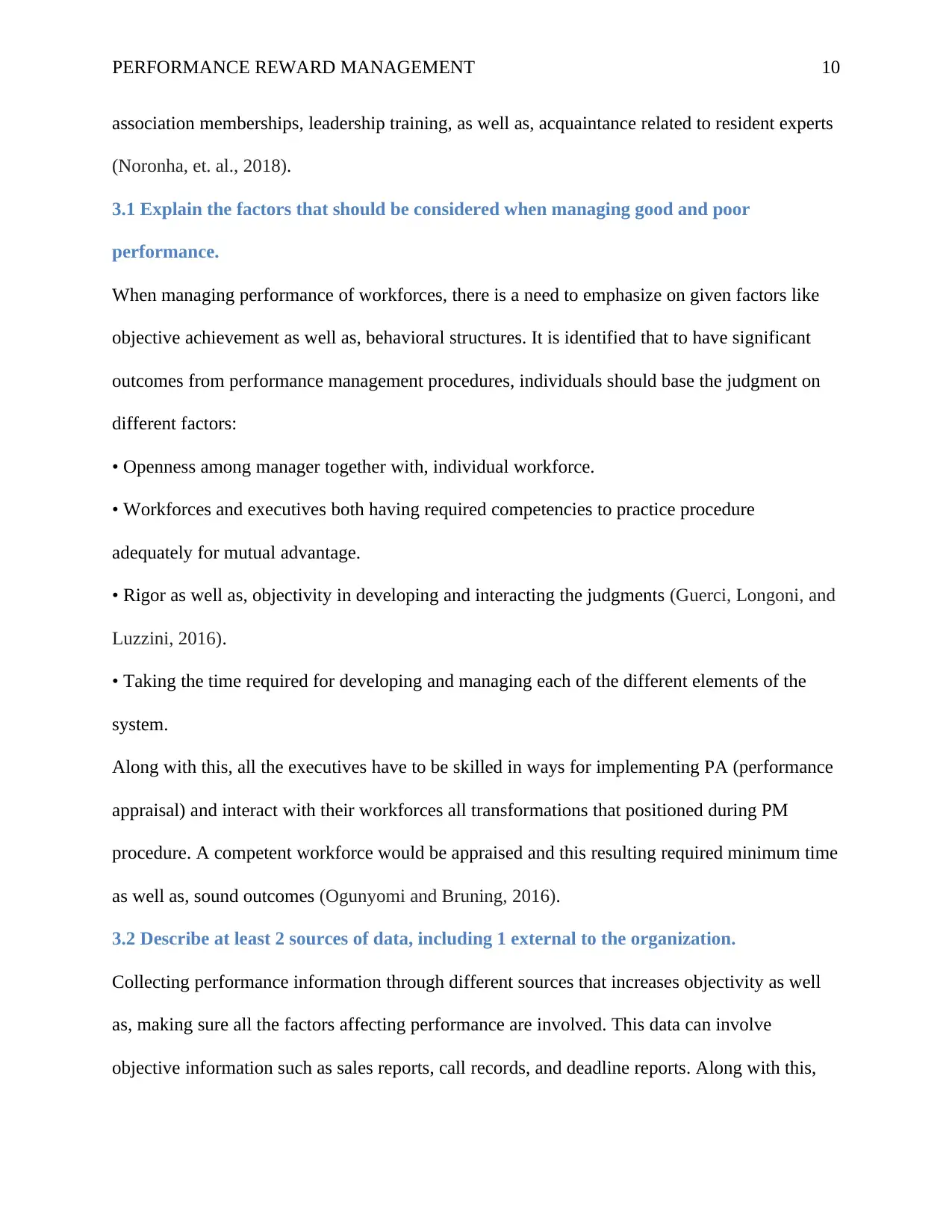
PERFORMANCE REWARD MANAGEMENT 10
association memberships, leadership training, as well as, acquaintance related to resident experts
(Noronha, et. al., 2018).
3.1 Explain the factors that should be considered when managing good and poor
performance.
When managing performance of workforces, there is a need to emphasize on given factors like
objective achievement as well as, behavioral structures. It is identified that to have significant
outcomes from performance management procedures, individuals should base the judgment on
different factors:
• Openness among manager together with, individual workforce.
• Workforces and executives both having required competencies to practice procedure
adequately for mutual advantage.
• Rigor as well as, objectivity in developing and interacting the judgments (Guerci, Longoni, and
Luzzini, 2016).
• Taking the time required for developing and managing each of the different elements of the
system.
Along with this, all the executives have to be skilled in ways for implementing PA (performance
appraisal) and interact with their workforces all transformations that positioned during PM
procedure. A competent workforce would be appraised and this resulting required minimum time
as well as, sound outcomes (Ogunyomi and Bruning, 2016).
3.2 Describe at least 2 sources of data, including 1 external to the organization.
Collecting performance information through different sources that increases objectivity as well
as, making sure all the factors affecting performance are involved. This data can involve
objective information such as sales reports, call records, and deadline reports. Along with this,
association memberships, leadership training, as well as, acquaintance related to resident experts
(Noronha, et. al., 2018).
3.1 Explain the factors that should be considered when managing good and poor
performance.
When managing performance of workforces, there is a need to emphasize on given factors like
objective achievement as well as, behavioral structures. It is identified that to have significant
outcomes from performance management procedures, individuals should base the judgment on
different factors:
• Openness among manager together with, individual workforce.
• Workforces and executives both having required competencies to practice procedure
adequately for mutual advantage.
• Rigor as well as, objectivity in developing and interacting the judgments (Guerci, Longoni, and
Luzzini, 2016).
• Taking the time required for developing and managing each of the different elements of the
system.
Along with this, all the executives have to be skilled in ways for implementing PA (performance
appraisal) and interact with their workforces all transformations that positioned during PM
procedure. A competent workforce would be appraised and this resulting required minimum time
as well as, sound outcomes (Ogunyomi and Bruning, 2016).
3.2 Describe at least 2 sources of data, including 1 external to the organization.
Collecting performance information through different sources that increases objectivity as well
as, making sure all the factors affecting performance are involved. This data can involve
objective information such as sales reports, call records, and deadline reports. Along with this,
Paraphrase This Document
Need a fresh take? Get an instant paraphrase of this document with our AI Paraphraser
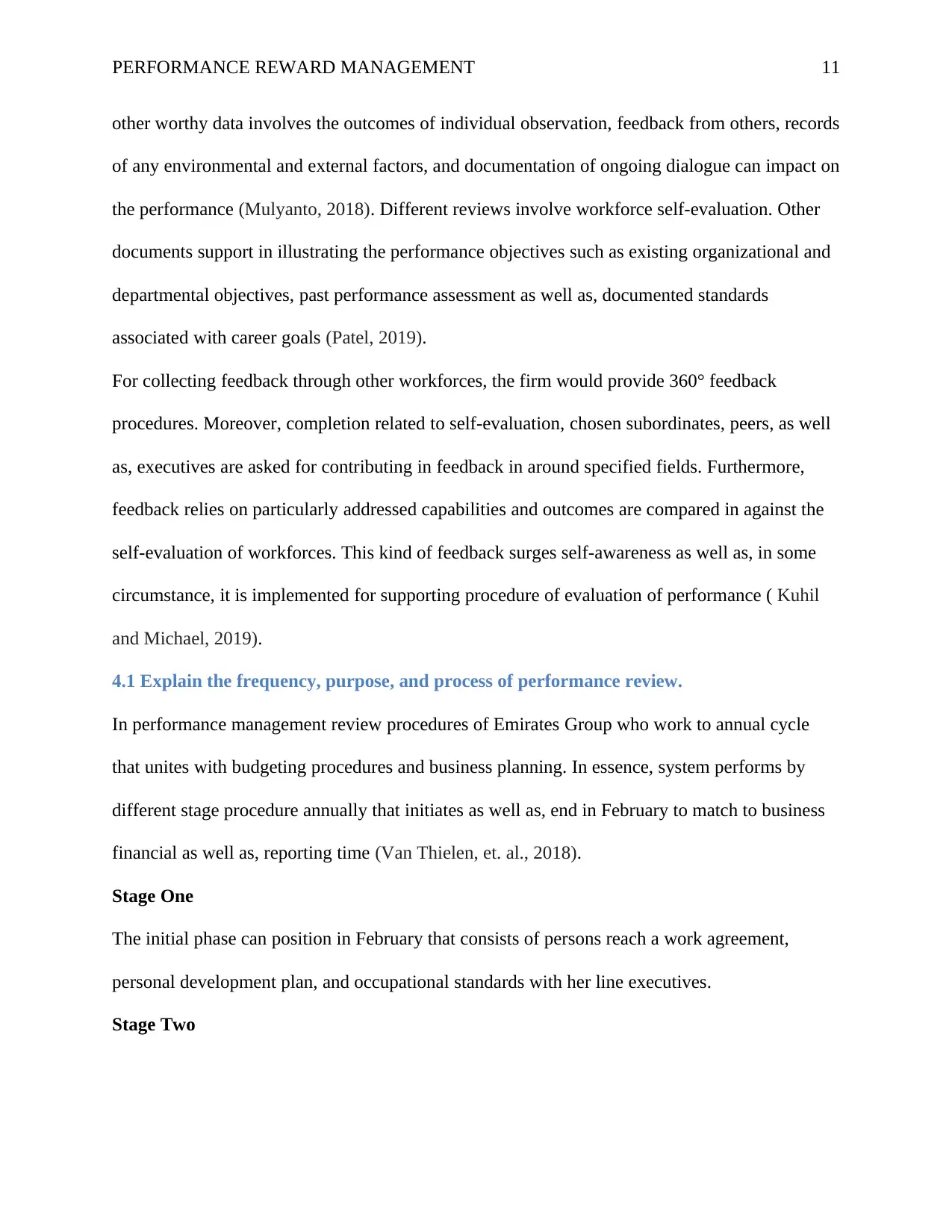
PERFORMANCE REWARD MANAGEMENT 11
other worthy data involves the outcomes of individual observation, feedback from others, records
of any environmental and external factors, and documentation of ongoing dialogue can impact on
the performance (Mulyanto, 2018). Different reviews involve workforce self-evaluation. Other
documents support in illustrating the performance objectives such as existing organizational and
departmental objectives, past performance assessment as well as, documented standards
associated with career goals (Patel, 2019).
For collecting feedback through other workforces, the firm would provide 360° feedback
procedures. Moreover, completion related to self-evaluation, chosen subordinates, peers, as well
as, executives are asked for contributing in feedback in around specified fields. Furthermore,
feedback relies on particularly addressed capabilities and outcomes are compared in against the
self-evaluation of workforces. This kind of feedback surges self-awareness as well as, in some
circumstance, it is implemented for supporting procedure of evaluation of performance ( Kuhil
and Michael, 2019).
4.1 Explain the frequency, purpose, and process of performance review.
In performance management review procedures of Emirates Group who work to annual cycle
that unites with budgeting procedures and business planning. In essence, system performs by
different stage procedure annually that initiates as well as, end in February to match to business
financial as well as, reporting time (Van Thielen, et. al., 2018).
Stage One
The initial phase can position in February that consists of persons reach a work agreement,
personal development plan, and occupational standards with her line executives.
Stage Two
other worthy data involves the outcomes of individual observation, feedback from others, records
of any environmental and external factors, and documentation of ongoing dialogue can impact on
the performance (Mulyanto, 2018). Different reviews involve workforce self-evaluation. Other
documents support in illustrating the performance objectives such as existing organizational and
departmental objectives, past performance assessment as well as, documented standards
associated with career goals (Patel, 2019).
For collecting feedback through other workforces, the firm would provide 360° feedback
procedures. Moreover, completion related to self-evaluation, chosen subordinates, peers, as well
as, executives are asked for contributing in feedback in around specified fields. Furthermore,
feedback relies on particularly addressed capabilities and outcomes are compared in against the
self-evaluation of workforces. This kind of feedback surges self-awareness as well as, in some
circumstance, it is implemented for supporting procedure of evaluation of performance ( Kuhil
and Michael, 2019).
4.1 Explain the frequency, purpose, and process of performance review.
In performance management review procedures of Emirates Group who work to annual cycle
that unites with budgeting procedures and business planning. In essence, system performs by
different stage procedure annually that initiates as well as, end in February to match to business
financial as well as, reporting time (Van Thielen, et. al., 2018).
Stage One
The initial phase can position in February that consists of persons reach a work agreement,
personal development plan, and occupational standards with her line executives.
Stage Two
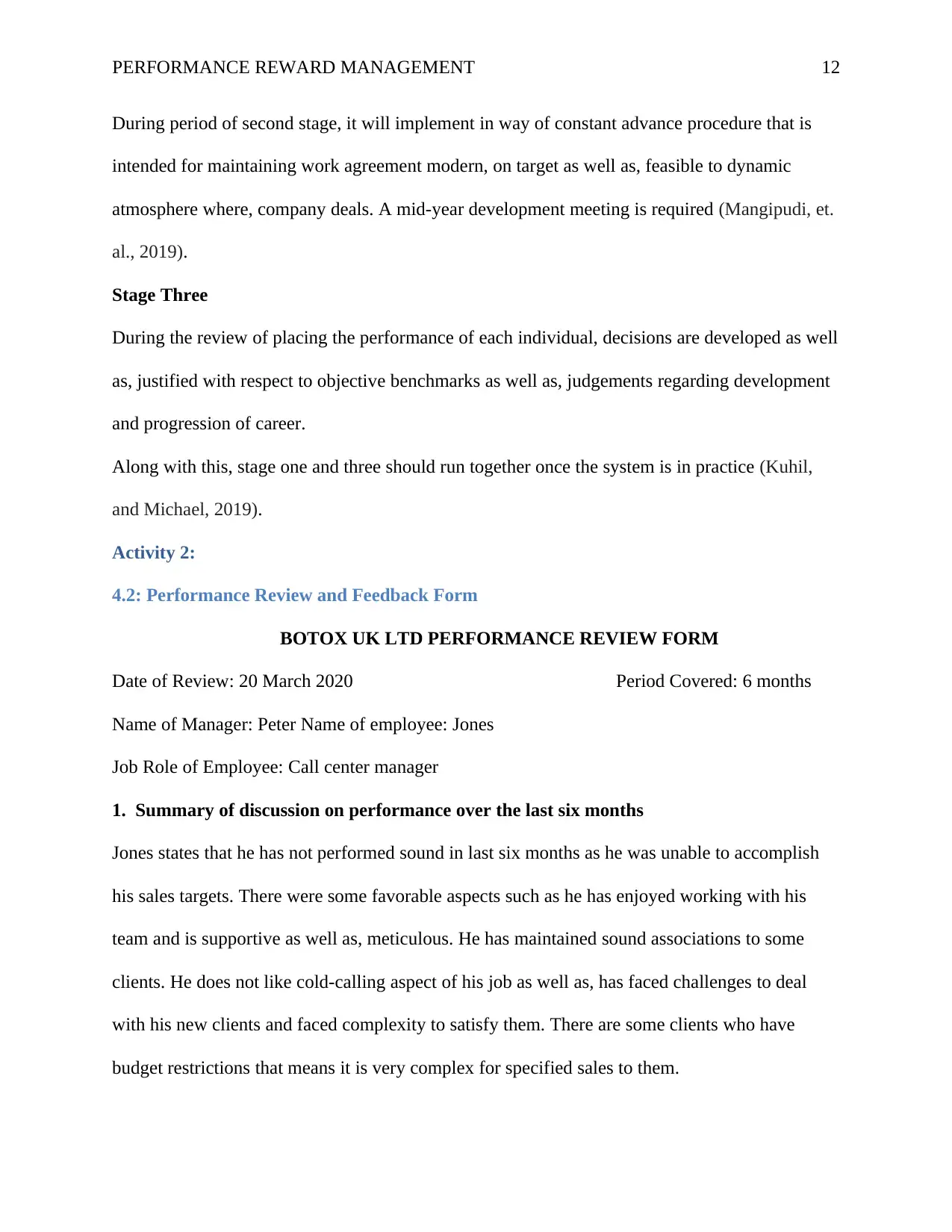
PERFORMANCE REWARD MANAGEMENT 12
During period of second stage, it will implement in way of constant advance procedure that is
intended for maintaining work agreement modern, on target as well as, feasible to dynamic
atmosphere where, company deals. A mid-year development meeting is required (Mangipudi, et.
al., 2019).
Stage Three
During the review of placing the performance of each individual, decisions are developed as well
as, justified with respect to objective benchmarks as well as, judgements regarding development
and progression of career.
Along with this, stage one and three should run together once the system is in practice (Kuhil,
and Michael, 2019).
Activity 2:
4.2: Performance Review and Feedback Form
BOTOX UK LTD PERFORMANCE REVIEW FORM
Date of Review: 20 March 2020 Period Covered: 6 months
Name of Manager: Peter Name of employee: Jones
Job Role of Employee: Call center manager
1. Summary of discussion on performance over the last six months
Jones states that he has not performed sound in last six months as he was unable to accomplish
his sales targets. There were some favorable aspects such as he has enjoyed working with his
team and is supportive as well as, meticulous. He has maintained sound associations to some
clients. He does not like cold-calling aspect of his job as well as, has faced challenges to deal
with his new clients and faced complexity to satisfy them. There are some clients who have
budget restrictions that means it is very complex for specified sales to them.
During period of second stage, it will implement in way of constant advance procedure that is
intended for maintaining work agreement modern, on target as well as, feasible to dynamic
atmosphere where, company deals. A mid-year development meeting is required (Mangipudi, et.
al., 2019).
Stage Three
During the review of placing the performance of each individual, decisions are developed as well
as, justified with respect to objective benchmarks as well as, judgements regarding development
and progression of career.
Along with this, stage one and three should run together once the system is in practice (Kuhil,
and Michael, 2019).
Activity 2:
4.2: Performance Review and Feedback Form
BOTOX UK LTD PERFORMANCE REVIEW FORM
Date of Review: 20 March 2020 Period Covered: 6 months
Name of Manager: Peter Name of employee: Jones
Job Role of Employee: Call center manager
1. Summary of discussion on performance over the last six months
Jones states that he has not performed sound in last six months as he was unable to accomplish
his sales targets. There were some favorable aspects such as he has enjoyed working with his
team and is supportive as well as, meticulous. He has maintained sound associations to some
clients. He does not like cold-calling aspect of his job as well as, has faced challenges to deal
with his new clients and faced complexity to satisfy them. There are some clients who have
budget restrictions that means it is very complex for specified sales to them.
⊘ This is a preview!⊘
Do you want full access?
Subscribe today to unlock all pages.

Trusted by 1+ million students worldwide
1 out of 29
Related Documents
Your All-in-One AI-Powered Toolkit for Academic Success.
+13062052269
info@desklib.com
Available 24*7 on WhatsApp / Email
![[object Object]](/_next/static/media/star-bottom.7253800d.svg)
Unlock your academic potential
Copyright © 2020–2025 A2Z Services. All Rights Reserved. Developed and managed by ZUCOL.





